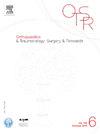在诱导膜(Masquelet)治疗胫骨脓毒性骨不连的第二阶段进行髓心钉固定,可以在不增加感染复发风险的情况下实现骨巩固,并且可以更早地恢复负重。
IF 2.2
3区 医学
Q2 ORTHOPEDICS
引用次数: 0
摘要
感染性骨不连是创伤学中最可怕的并发症之一。采用诱导膜技术进行两阶段治疗是一种有效的治疗选择,但迄今为止,对于第二阶段手术的理想植骨方式尚无共识。本研究的目的是比较两阶段治疗胫骨脓毒性骨不连的结果,这取决于所使用的骨合成类型。假设:我们的假设是在脓毒性胫骨骨不连治疗的第二阶段进行髓心内钉内固定可以实现骨愈合和感染愈合,同时可以更快地恢复负重,而不会增加并发症的发生率。材料和方法:这是一项回顾性单中心连续比较研究,包括2008年1月至2018年7月治疗的所有2期胫骨脓毒性骨不连,至少随访18个月。根据所采用的骨融合术的类型,比较愈合率和脓毒症再激活率,以及愈合时间和肢体负重。原发性成功定义为脓毒性骨不连的恢复,继发性成功定义为至少一次额外手术后的恢复。结果:纳入49例患者,年龄39.5±14.8岁。一期和二期成功率分别为77.6%(38/49)和87.8%(43/49),平均随访29.4 +/-11.3个月。内固定不会比外固定导致更多脓毒性再激活(p = 0.49),同时允许在相同期限内愈合。与钢板(4.8 +/-1.5个月)或外固定架(5.3 +/-1.8个月)相比,髓心钉植骨可以更早地承受重量(1.5 +/-0.9个月)(p结论:在骨不连治愈的第二阶段,二次转化为内植骨可以在相同的延迟内实现巩固,而不会增加感染复发的风险。它还可以使手术肢体更快地承受重量,特别是在髓心钉入的情况下。证据等级:III;比较研究。本文章由计算机程序翻译,如有差异,请以英文原文为准。
Centromedullary nailing during the second stage of induced membrane (Masquelet) for tibia septic nonunion enables bone union to be achieved without increasing the risk of recurrence of infection, with an earlier return to weight-bearing
Introduction
Septic nonunion is one of the most feared complications in traumatology. Two-stage management using the induced membrane technique is a validated treatment option, but to date there is no consensus on the ideal type of osteosynthesis for the second stage of surgery. The aim of this study was to compare the results of two-stage treatment of tibial septic nonunion, depending on the type of osteosynthesis used.
Hypothesis
Our hypothesis was that internal centromedullary nailing osteosynthesis during the second stage of management of septic tibia nonunion would achieve bone union and healing of the infection, while allowing faster resumption of weight-bearing without increasing the complication rate.
Material & methods
This was a retrospective monocentric continuous comparative study including all 2-stage tibial septic nonunions treated from January 2008 to July 2018, with a minimum follow-up of 18 months. Healing and septic reactivation rates, as well as time to union and weight-bearing on the limb, were compared according to the type of osteosynthesis used. Primary success was defined as recovery from septic nonunion, and secondary success as recovery after at least one additional surgical procedure.
Results
Forty-nine patients were included, aged 39.5 +/− 14.8 years. Primary and secondary success rates were 77.6% (38/49) and 87.8% (43/49), with a mean follow-up of 29.4 +/− 11.3 months. Internal osteosynthesis did not lead to more septic reactivation than external stabilization (p = 0.49), while allowing union within the same deadlines. Osteosynthesis with a centromedullary nail allowed earlier weight-bearing (1.5 +/− 0.9 months) vs. plate (4.8 +/− 1.5) or vs. external fixator (5.3 +/− 1.8) (p < 0.001).
Conclusion
Secondary conversion to internal osteosynthesis during the second stage of nonunion cure allows consolidation in same delays, without increasing the risk of infectious recurrence. It also enables faster weight-bearing on the operated limb, particularly in the case of centromedullary nailing.
Level of evidence
III; comparative study.
求助全文
通过发布文献求助,成功后即可免费获取论文全文。
去求助
来源期刊
CiteScore
5.10
自引率
26.10%
发文量
329
审稿时长
12.5 weeks
期刊介绍:
Orthopaedics & Traumatology: Surgery & Research (OTSR) publishes original scientific work in English related to all domains of orthopaedics. Original articles, Reviews, Technical notes and Concise follow-up of a former OTSR study are published in English in electronic form only and indexed in the main international databases.

 求助内容:
求助内容: 应助结果提醒方式:
应助结果提醒方式:


